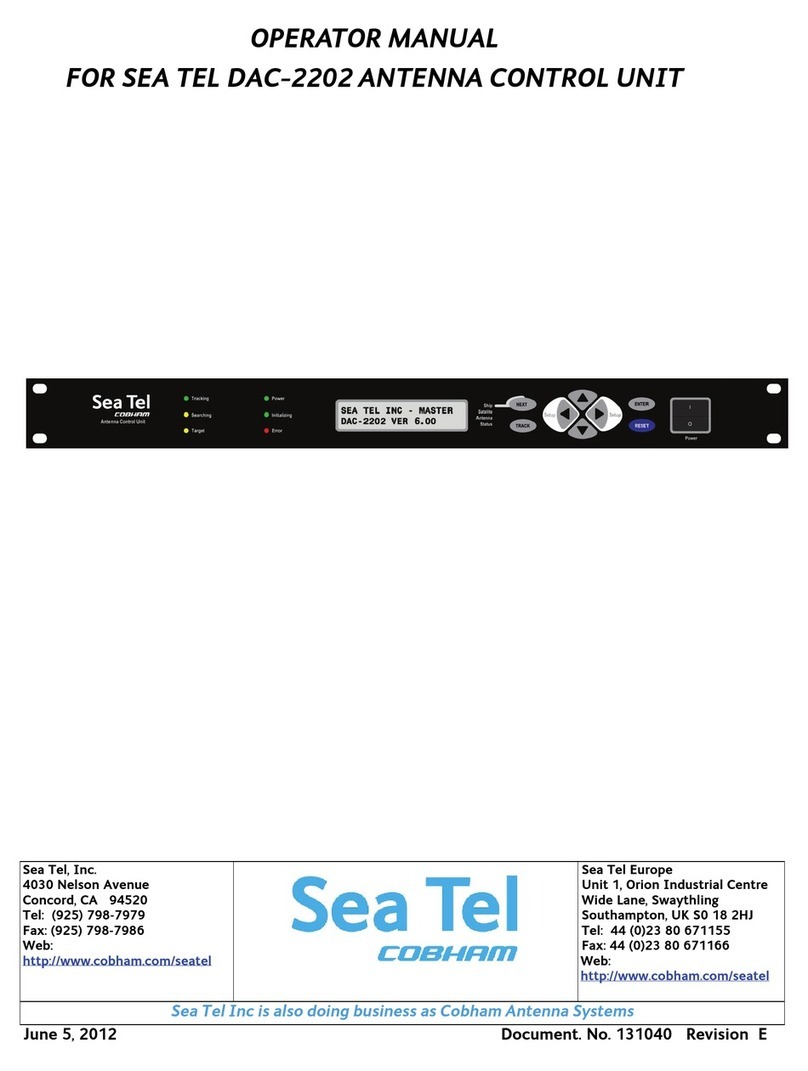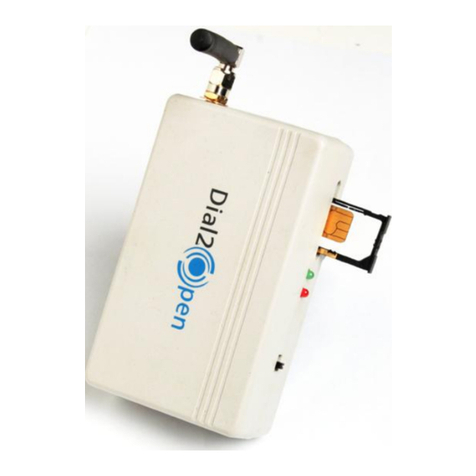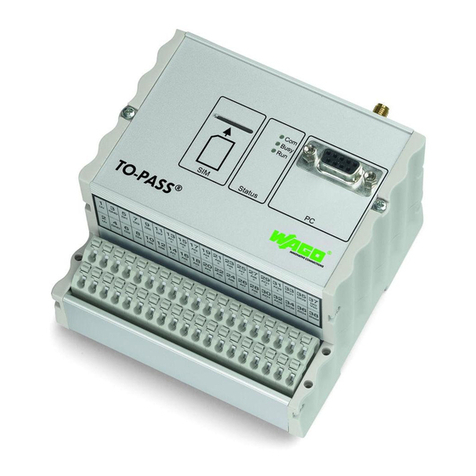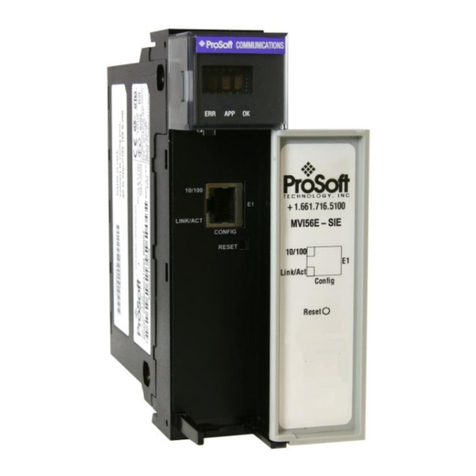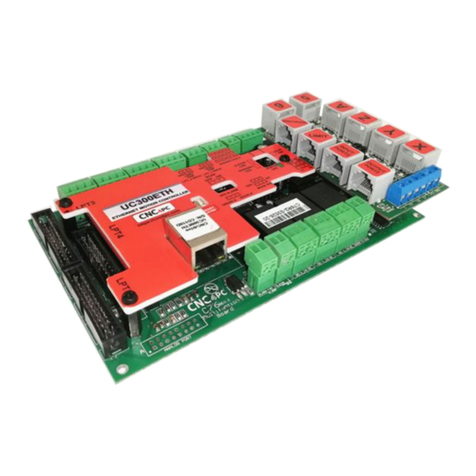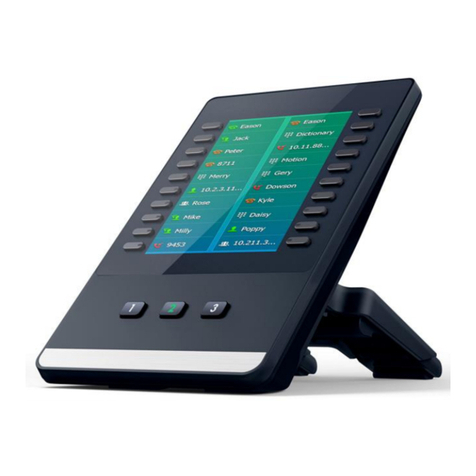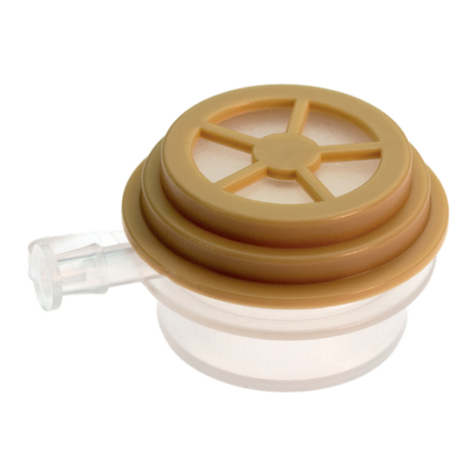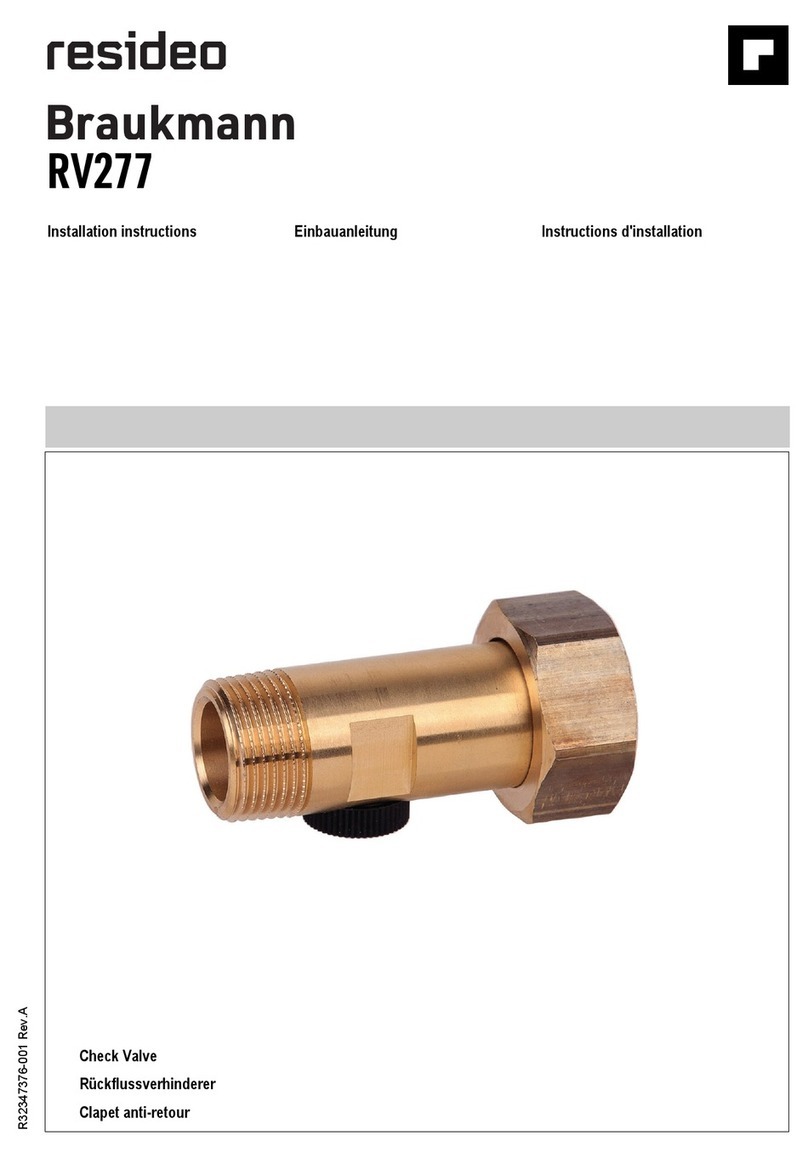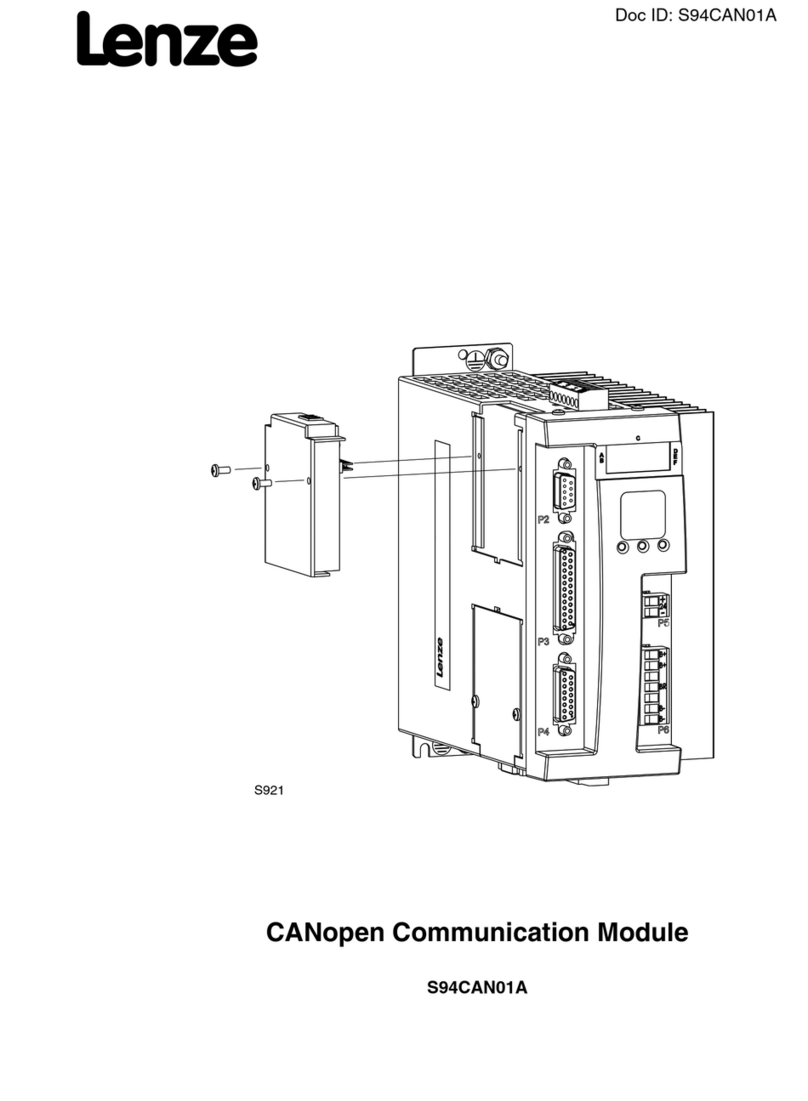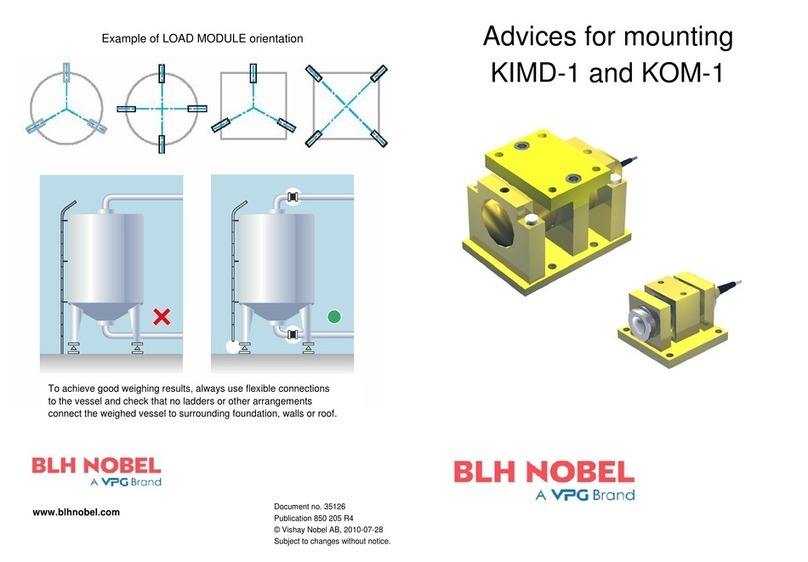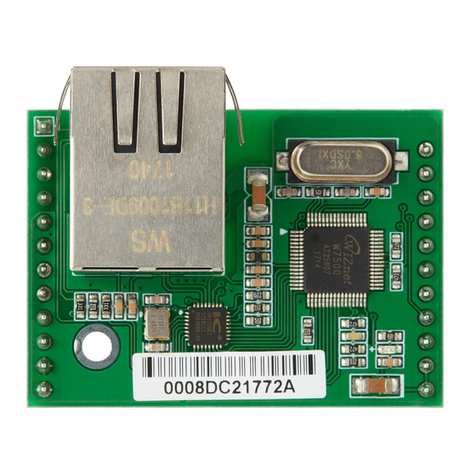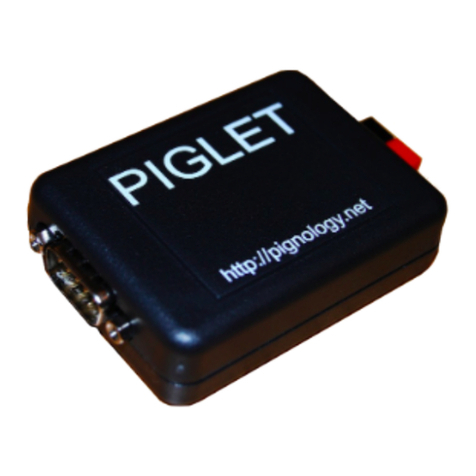Sea Tel DAC-2202 User manual

Sea Tel, Inc.
4030 Nelson Avenue
Concord, CA 94520
Tel: (925) 798-7979
Fax: (925) 798-7986
Email: seatel@cobham.com
Web: www.cobham.com\seatel
Sea Tel Europe
Unit 1, Orion Industrial Centre
Wide Lane, Swaythling
Southampton, UK S0 18 2HJ
Tel: 44 (0)23 80 671155
Fax: 44 (0)23 80 671166
Email: seatel@cobham.com
Web: www.cobham.com\seatel
Sea Tel Inc doing business as Cobham SATCOM
October 28, 2008 Document. No. 126523 Revision E1
INSTALLATION AND OPERATION MANUAL
FOR SEA TEL MODEL
DAC-2202 ANTENNA CONTROL UNIT

ii
These commodities, technology or software were exported from the
United States in accordance with the Export Administration Regulations.
Diversion contrary to U.S. law is prohibited.
Sea Tel Marine Stabilized Antenna systems are manufactured in the
United States of America.
Sea Tel is an ISO 9001:2000 registered company. Certificate Number 19.2867 was
issued August 12, 2005. Sea Tel was originally registered on November 09, 1998.
The DAC-2200 Antenna Control Unit (exclusively for use with Sea Tel Marine
Stabilized Antenna Pedestals) complies with the requirements of European Norms and
European Standards EN 60945 (1997) and prETS 300 339 (1998-03). Sea Tel
European Union Declaration of Conformity for this equipment is contained in this
manual.
Copyright Notice
All Rights Reserved. The information contained in this document is proprietary to Sea Tel, Inc.. This
document may not be reproduced or distributed in any form without the consent of Sea Tel, Inc.
The information in this document is subject to change without notice.
Copyright © 2007 Sea Tel, Inc.


iv
Revision History
REV ECO# Date Description By
A N/A May 23, 2007 Production release ECM
A1 N/A May 30, 2007 Updated Installation Text MDN
A2 N/A June 7, 2007 Updated Setup Text MDN
B N/A July 5, 2007 Updated Text per engineering dept. feedback ECM
C N/A October 3, 2007 Updated text and added text as required ECM
D N/A December 12, 2007 Updated text to include SCPC functionality and internal HTML
page
ECM
E N/A April 18, 2008 Updated text to include new search, new blockage mapping
including EL Limits and added SCPC receivers
MDN
E1 N/A October 28, 2008 Updated logo and font MDN

DAC-2202 Antenna Control Unit Table of Contents
v
1. INTRODUCTION ......................................................................................................................................................................1-1
1.1. GENERAL DESCRIPTION OF SYSTEM ......................................................................................................................................1-1
1.2. GENERAL SCOPE OF THIS MANUAL .......................................................................................................................................1-2
1.3. QUICK OVERVIEW OF CONTENTS ..........................................................................................................................................1-2
2. OPERATION.................................................................................................................................................................................2-1
2.1. QUICK START OPERATION.......................................................................................................................................................2-1
2.2. FRONT PANEL LAYOUT .............................................................................................................................................................2-1
2.3. BASIC FUNCTION OF FRONT PANEL KEYS............................................................................................................................2-2
2.4. BASIC DESCRIPTION OF FRONT PANEL STATUS LEDS......................................................................................................2-2
2.5. DISPLAY &ENTRY OPERATION MENUS................................................................................................................................2-3
2.5.1. Ship Information Menus.....................................................................................................................................2-4
2.5.2. Satellite Information Menus. ...........................................................................................................................2-5
2.5.3. Antenna Information Menus. ..........................................................................................................................2-9
2.5.4. Status information menus. ............................................................................................................................. 2-10
2.5.5. SETUP Parameter display and entry menus.......................................................................................... 2-11
2.6. TRACKING OPERATION..........................................................................................................................................................2-11
2.6.1. DishScan Operation............................................................................................................................................ 2-12
2.7. SEARCHING OPERATION........................................................................................................................................................2-12
2.7.1. Default Standard (Box) Search Pattern ................................................................................................... 2-13
2.7.2. Inclined Orbit Search Pattern....................................................................................................................... 2-13
2.7.3. No Gyro Search Pattern................................................................................................................................... 2-14
2.8. AUTO-POLARIZATION OPERATION.....................................................................................................................................2-15
2.9. RADOME ASSEMBLY OPERATION ........................................................................................................................................2-15
3. BASIC SYSTEM INFORMATION.................................................................................................................................3-17
3.1. SATELLITE BASICS ..................................................................................................................................................................3-17
3.1.1. C-Band Receive Frequency (3.7-4.2GHz) ................................................................................................ 3-17
3.1.2. Ku-Band Receive Frequency (10.95-12.75GHz)................................................................................... 3-17
3.1.3. Blockage................................................................................................................................................................... 3-17
3.1.4. Rain Fade.................................................................................................................................................................. 3-17
3.1.5. Signal level............................................................................................................................................................... 3-18
3.1.6. Satellite Footprint Charts................................................................................................................................ 3-18
3.1.7. Linear Satellite polarization............................................................................................................................ 3-18
3.2. ANTENNA BASICS...................................................................................................................................................................3-18
3.2.1. Stabilization............................................................................................................................................................ 3-19
3.2.2. Azimuth..................................................................................................................................................................... 3-19
3.2.3. Elevation................................................................................................................................................................... 3-19
3.2.4. Antenna polarization......................................................................................................................................... 3-20
3.2.5. Tracking Receivers .............................................................................................................................................. 3-20
3.2.6. Tracking.................................................................................................................................................................... 3-20
3.3. COMPONENTS OF THE SYSTEM CONFIGURATION...........................................................................................................3-20
3.3.1. Antenna ADE Assembly ................................................................................................................................... 3-21
3.3.2. Antenna Control Unit ........................................................................................................................................ 3-21
3.3.3. Below Decks AC Power Supply..................................................................................................................... 3-21
4. INSTALLATION.........................................................................................................................................................................4-1
4.1. GENERAL CAUTIONS &WARNINGS.......................................................................................................................................4-1

Table of Contents DAC-2202 Antenna Control Unit
vi
4.2. SITE SURVEY............................................................................................................................................................................... 4-1
4.3. PREPARING FOR THE INSTALLATION..................................................................................................................................... 4-1
4.3.1. Unpack Shipping Crates and Inspect / Inventory ................................................................................ 4-1
4.3.2. Preparing BDE Location...................................................................................................................................... 4-1
4.3.3. Read the Installation Information................................................................................................................ 4-1
4.3.4. Plan The Install........................................................................................................................................................ 4-1
4.3.5. The Installing Cables............................................................................................................................................ 4-1
4.4. INSTALL THE ACU..................................................................................................................................................................... 4-2
4.5. INSTALL THE TERMINAL MOUNTING STRIP (TMS) .......................................................................................................... 4-2
4.6. INSTALL THE BASE MULTIPLEXER PANEL ............................................................................................................................. 4-2
4.7. TERMINAL MOUNTING STRIP (TMS) CONNECTIONS...................................................................................................... 4-2
4.8. AC POWER TO THE ACU........................................................................................................................................................ 4-4
4.9. AGC TRACKING CONNECTION............................................................................................................................................... 4-4
4.10. MONITOR AND CONTROL CONNECTIONS........................................................................................................................... 4-4
4.11. INSTALL OTHER BDE EQUIPMENT......................................................................................................................................... 4-5
4.12. FINAL CHECKS............................................................................................................................................................................ 4-5
4.12.1. Visual/Electrical inspection............................................................................................................................... 4-5
4.13. POWER-UP.................................................................................................................................................................................. 4-5
4.14. SETUP........................................................................................................................................................................................... 4-5
5. SETUP ..............................................................................................................................................................................................5-1
5.1. OPERATOR SETTINGS................................................................................................................................................................ 5-1
5.2. DEFAULT SETUP PARAMETERS FOR YOUR ANTENNA ....................................................................................................... 5-1
5.3. SETUP PARAMETER DISPLAY AND ENTRY MENUS............................................................................................................. 5-1
5.4. EL TRIM ..................................................................................................................................................................................... 5-1
5.5. AZ TRIM.................................................................................................................................................................................... 5-2
5.6. AUTO THRES........................................................................................................................................................................... 5-2
5.7. EL STEP SIZE............................................................................................................................................................................ 5-2
5.8. AZ STEP SIZE .......................................................................................................................................................................... 5-2
5.9. STEP INTEGRAL ..................................................................................................................................................................... 5-3
5.10. SEARCH INC ............................................................................................................................................................................ 5-3
5.11. SEARCH LIMIT ....................................................................................................................................................................... 5-3
5.12. SWEEP INC............................................................................................................................................................................... 5-3
5.13. SYSTEM TYPE ......................................................................................................................................................................... 5-4
5.14. GYRO TYPE............................................................................................................................................................................... 5-4
5.15. POLANG TYPE......................................................................................................................................................................... 5-4
5.16. POL OFFSET............................................................................................................................................................................. 5-5
5.17. POL SCALE................................................................................................................................................................................ 5-5
5.18. RADIATION HAZARD AND BLOCKAGE MAPPING (AZ LIMIT PARAMETERS)............................................................... 5-5
5.19. 5V OFFSET (MAY NOT BE IN YOUR SOFTWARE)........................................................................................................... 5-10
5.20. 5V SCALE (MAY NOT BE IN YOUR SOFTWARE).............................................................................................................. 5-10
5.21. TX POLARITY........................................................................................................................................................................... 5-10
5.22. TRACK DISP.......................................................................................................................................................................... 5-10
5.23. SAVE NEW PARAMETERS .............................................................................................................................................. 5-11
5.24. REMOTE COMMAND ....................................................................................................................................................... 5-11
5.25. REMOTE MONITOR........................................................................................................................................................... 5-11

DAC-2202 Antenna Control Unit Table of Contents
vii
5.26. TO DISABLE/ENABLE DISHSCAN.........................................................................................................................................5-11
5.27. SATELLITE REFERENCE MODE ..............................................................................................................................................5-12
5.28. REMOTE TILT.......................................................................................................................................................................5-12
5.29. REMOTE PARAMETERS ...................................................................................................................................................5-12
5.30. REMOTE UPLOAD...............................................................................................................................................................5-12
6. FUNCTIONAL TESTING ......................................................................................................................................................6-1
6.1. ACU /ANTENNA SYSTEM CHECK..........................................................................................................................................6-1
6.2. LATITUDE/LONGITUDE AUTO-UPDATE CHECK...................................................................................................................6-1
6.3. SHIP HEADING –GYRO COMPASS FOLLOWING CHECK....................................................................................................6-1
6.4. AZIMUTH &ELEVATION DRIVE..............................................................................................................................................6-1
6.5. FOUR QUADRANT TRACKING TEST .......................................................................................................................................6-1
6.6. BLOCKAGE SIMULATION TEST................................................................................................................................................6-2
6.7. CHECK ACU PARAMETERS ......................................................................................................................................................6-3
7. MAINTENANCE & TROUBLESHOOTING .................................................................................................................7-1
7.1. GENERAL CAUTIONS &WARNINGS.......................................................................................................................................7-1
7.2. TROUBLESHOOTING THE ACU ...............................................................................................................................................7-1
7.2.1. ACU display is blank ..............................................................................................................................................7-1
7.2.2. ACU Status displays "REMOTE NOT RESPONDING" ............................................................................7-1
7.3. TROUBLESHOOTING SHIPS GYRO COMPASS PROBLEMS ...................................................................................................7-1
7.3.1. STEP-BY-STEP...........................................................................................................................................................7-2
7.3.2. 1:1 SYNCHRO ............................................................................................................................................................7-2
7.3.3. 360:1 Synchro ..........................................................................................................................................................7-3
7.4. DISPLAY OFFSETS /OPTIMIZING TARGETING ....................................................................................................................7-3
7.5. PEDESTAL CONTROL UNIT CONFIGURATION......................................................................................................................7-3
7.6. CONFIGURING THE COMM IF PORTS OF THE DAC-2202 ACU..................................................................................7-3
7.7. PROGRAMMING INSTRUCTIONS ANTENNA CONTROL UNIT ...........................................................................................7-6
7.8. PROGRAMMING INSTRUCTIONS PEDESTAL CONTROL UNIT............................................................................................7-9
7.9. COMMUNICATIONS INTERFACE (COMMIF PCB) SOFTWARE UPLOAD INSTRUCTIONS........................................7-12
7.10. INTERNAL HTML PAGE .........................................................................................................................................................7-14
7.10.1. System Information........................................................................................................................................... 7-15
7.10.2. Communication Port Settings ...................................................................................................................... 7-16
7.10.3. DAC Parameters Page 1................................................................................................................................... 7-18
7.10.4. DAC Parameters Page 2................................................................................................................................... 7-19
7.10.5. Status Page ............................................................................................................................................................. 7-20
8. TECHNICAL SPECIFICATIONS......................................................................................................................................8-1
8.1. DAC-2202 ANTENNA CONTROL UNIT ...............................................................................................................................8-1
8.1.1. General.........................................................................................................................................................................8-1
8.1.2. Front Panel.................................................................................................................................................................8-1
8.1.3. Rear Panel...................................................................................................................................................................8-1
8.1.4. J4A “Antenna” Pedestal M&C Interface .....................................................................................................8-1
8.1.5. J4B “Antenna” Pedestal M&C Interface......................................................................................................8-2
8.1.6. J3 “M&C” Aux Serial Interface .........................................................................................................................8-2
8.1.7. J2 “NMEA A” Interface.........................................................................................................................................8-2
8.1.8. J2 “NMEA B” Interface.........................................................................................................................................8-2
8.1.9. Ethernet.......................................................................................................................................................................8-2

Table of Contents DAC-2202 Antenna Control Unit
viii
8.1.10. DVB Compliant Tracking Receiver................................................................................................................. 8-3
8.1.11. L-Band SCPC Narrow Band Tracking Receiver........................................................................................ 8-3
8.1.12. Narrow Band SCPC receiver: ............................................................................................................................ 8-3
8.2. TERMINAL MOUNTING STRIP................................................................................................................................................. 8-3
8.2.1. Synchro Interface:................................................................................................................................................. 8-3
8.2.2. SBS Interface............................................................................................................................................................ 8-4
8.2.3. Control Interface ................................................................................................................................................... 8-4
8.2.4. NMEA Interface...................................................................................................................................................... 8-4
8.3. ENVIRONMENTAL CONDITIONS ............................................................................................................................................. 8-4
8.4. CABLES......................................................................................................................................................................................... 8-5
8.4.1. DAC-2200 AC Power Cable............................................................................................................................... 8-5
8.4.2. Antenna Control Cable........................................................................................................................................ 8-5
8.4.3. IF Signal Cables ...................................................................................................................................................... 8-5
8.4.4. SBS/Synchro Gyro Compass Interface Cable (Customer Furnished)......................................... 8-5
8.4.5. Audio / Video cables ............................................................................................................................................. 8-5
9. DRAWINGS ..................................................................................................................................................................................9-1
9.1. DAC-2202 ANTENNA CONTROL UNIT DRAWINGS......................................................................................................... 9-1

DAC-2202 Antenna Control Unit Introduction
1-1
1. Introduction
This manual describes the Sea Tel Model DAC-2202 Series of shipboard Tracking Antenna Control
Units (ACU). System information, installation, setup, operating instructions, functional testing and
maintenance for the ACU are also contained herein.
This ACU allows you to control the antenna that it is connected to. It also allows you to connect your
Gyro Compass to provide heading input to the system for accurate targeting of satellites.
1.1. General Description of System
The Antenna Control Unit (ACU) has been designed and manufactured so as to be inherently reliable, easy
to maintain, and simple to operate. Except for start-ups, or when changing to operate with different
transponders or satellites, the equipment essentially permits unattended operation.
This ACU is housed in a standard 1 Unit high, 19-inch rack mount enclosure. The front panel contains
function keys used to select the desired information to be displayed, and/or changed. Data is displayed on a
2 line 20 character display. All external connections are interfaced through connectors mounted on the rear
panel.
The shipboard gyrocompass input is used as the long-term azimuth reference. The ACU accepts gyro
compass input from Step-By-Step OR 1:1, 36:1, 90:1 or 360:1 Synchro OR NMEA 0183 serial interface. A
GPS antenna is provided on your antenna pedestal to provide Latitude and Longitude location for the
system.
The ACU automatically calculates the Elevation, Azimuth and Polarization pointing angles based on the
ships Latitude, Longitude and the desired Satellite Longitude position. A programmable pattern search will
automatically scan the area for a desired satellite if no signal is found. These two features make locating a
new satellite very easy.
The internal Satellite ID Tracking Receiver (DVB Receiver) uses received satellite signal input to keep the
antenna peaked on satellite. This internal digital receiver allows you to tune it to any frequency in the 950
to 2150 MHz range for tracking a wide bandwidth satellite signal.
It is normally connected to an Antenna and other equipment to form a system. The system consists of two
major groups of equipment; an above-decks group and a below-decks group. Each group is comprised of,
but not limited to, the items listed below. All equipment comprising the Above Decks is incorporated inside
the radome assembly and is integrated into a single operational entity. For operation, this system requires
only an unobstructed line-of-sight view to the satellite, GPS Latitude & Longitude input (provided with
antenna pedestal), Ship’s Gyro Compass input and AC electrical power.
The following text provides a basic functional overview of the system components and component
interconnection as referred to in the System Block Diagram(s) for your model antenna.
Television Receive Only (TVRO) Systems are comprised of two major sections: The Above-Decks Equipment
(ADE) is comprised of the Sea Tel antenna & radome assembly which is mounted outside, on an upper deck
location chosen for best satellite reception. The Below-Decks Equipment (BDE) includes the Antenna
Control Unit and will have satellite receiver(s), TV set(s) and all other ancillary equipment that is mounted in
various locations throughout the interior of the ship. Refer to your antenna manual for more specific
configuration information.
Transmit/Receive (TXRX) Systems are also comprised of two major sections: The Above-Decks Equipment
(ADE) is comprised of the Sea Tel antenna & radome assembly which is mounted outside, on an upper deck
location chosen for best satellite reception. The Antenna inside the radome has Transmit & Receive RF
equipment mounted on it. The Below-Decks Equipment (BDE) includes the Antenna Control Unit and will
have satellite modem, multiplexer and all other ancillary communications equipment that is mounted in
various locations throughout the interior of the ship. Refer to your antenna manual for more specific
configuration information.

Introduction DAC-2202 Antenna Control Unit
1-2
1.2. General Scope of This Manual
This manual describes operation and installation of this Antenna Control Unit.
1.3. Quick Overview of Contents
The information in this manual is organized into chapters; Operation, Installation, Setup, Functional Testing,
Maintenance & Troubleshooting, Technical Specifications and Drawings.

DAC-2202 Antenna Control Unit Operation
2-1
2. Operation
When power is turned ON, the ACU Display will initially show “SEA TEL INC - MASTER” and the ACU software
version (ie DAC-2202 VER 6.xx ). 10 seconds later, the display will switch to “SEA TEL INC - REMOTE” and
“INITIALIZING” for approximately two minutes while the Pedestal Control Unit (PCU) completes initialization of
the antenna pedestal and then reports its Model & Software version.
2.1. Quick Start Operation
If your system has been set up correctly and the ship has not moved since the system was used last.
Operation of the system from a cold start involves the following steps.
1. Turn on the AC power switches for the Antenna Control Unit (ACU) and other Below Decks
Equipment..
2. Press NEXT until the Ship menu is displayed to check the Latitude, Longitude and Heading values.
Latitude and Longitude should still be correct, but may be updated if necessary. Heading in most
cases will be 000.0 and you will have to enter the initial value of the ships current heading. Entry of
ships heading is not required when your system is connected to a 1:1 Synchro or NMEA 0183
Heading Gyro Compass output. Press ENTER 3 times to select ship's heading (HDG) entry mode.
Use the LEFT arrow to bring the cursor up under the ones digit, then if desired,
increment/decrement it using the UP/DOWN arrow keys. Use the LEFT/RIGHT arrow keys to
select other digits to modify and the UP/DOWN arrow key to modify them as needed to enter the
current ships gyro heading. Press ENTER to save the value. Press NEXT to return to the Ship
display menu.
3. If System Type parameter includes value 1, the ACU should automatically target the last satellite
that was used. If it does not, press NEXT to the Satellite display menu so you can manually target
the satellite. If you are targeting the SAME satellite longitude as was used last; Press ENTER, then
the LEFT (or RIGHT) arrow and then ENTER to target the same satellite. If you are targeting a
different satellite you will need to change the tracking parameters and then target the desired
satellite, refer to the operation section for the Satellite menu below.
A. If no signal is found: The Tracking LED will flash for a short period of time (per the SEARCH DELAY
parameter) followed by the Search LED coming ON. The ACU will automatically move the antenna in a
spiral SEARCH pattern until the ACU receives a signal (AGC) value that is greater than the threshold value.
Tracking will take over (Tracking LED ON) and automatically peak the antenna position for highest receive
signal level from the satellite which has been acquired.
B. If a satellite signal is found: The received signal level (AGC) will be higher than the threshold value.
Tracking will take over (Tracking LED ON) and automatically peak the antenna position for highest receive
signal level from the satellite.
Upon completion of the above, the system will continue to operate automatically indefinitely until; AC
power to the system is interrupted OR The satellite signal is blocked OR The ship sails into an area of
insufficient satellite signal level.
2.2. Front Panel Layout

Operation DAC-2202 Antenna Control Unit
2-2
2.3. Basic Function of Front Panel Keys
Keyboard operation is very simple and straightforward. Basic function of each key is:
Press NEXT to cycle through the four main menus; Ship, Satellite, Antenna and
Status (refer to the Operation Flowcharts).
Press TRACK key to toggle the state of Tracking, ON/OFF. If SEARCH is ON, pressing
the TRACK key will turn search OFF.
When the Antenna main menu is displayed, pressing the LEFT arrow moves the
antenna left (CCW or down in azimuth). Pressing the RIGHT arrow to move the
antenna right (CW or up in azimuth).
In any sub-menu, pressing the LEFT or RIGHT arrow enters editing mode and brings
up a cursor in the display. When the cursor is under a character, it is selected and
can be changed (see UP/DOWN arrow below).
(Setup) - Press and release BOTH the LEFT and RIGHT arrow keys to access the
save parameters window. Press & Hold for six seconds to access the setup
parameters (refer to the Setup section of this manual).
When the Antenna main menu is displayed, press UP arrow to move the antenna up
in elevation or the DOWN arrow to move the antenna down in elevation.
Press the UP/DOWN arrow cycle Up and Down through the sub-menus.
When a sub-menu item is being edited, use the UP/DOWN to increment/decrement
the selected character. This steps the selected entry one increment per sequential
key-press or rapidly increments the selected entry when pressed & held.
At any main menu level, press ENTER to access the sub-menu items.
When viewing one of the sub-menus, pressing the ENTER key will step down through
the sub-menu items, like the DOWN arrow does.
When editing, the cursor is visible under a character in a sub-menu (whether it has
been changed or not), press ENTER to execute the present value, and return to
display mode of that sub-menu. This does NOT save the new value to NVRAM.
Press RESET to reset all the processors in the Antenna Control Unit. It does NOT
reset the antenna.
2.4. Basic Description of Front Panel Status LEDs
The basic description of the front panel LED states are:
Tracking - (Green LED)
ON indicates that the ACU has identified and is actively tracking the desired satellite to optimize
the signal level (AGC).
Blinking indicates that the ACU is in search delay or is analyzing a satellite signal.
OFF indicates that Tracking is OFF.
Searching - (Yellow LED)
ON indicates that the ACU is actively searching for your satellite signal.
OFF indicates that SEARCH is OFF.
Target - (Yellow LED)
ON indicates that the antenna is TARGETING (driving) to the specified Azimuth and/or Elevation
position(s).
ON also indicates UNWRAP in limited azimuth antennas.

DAC-2202 Antenna Control Unit Operation
2-3
Power - (Green LED)
ON indicates that the Antenna Control Unit is energized.
Initializing - (Green LED)
ON indicates that the Antenna is initializing. Initialization of the antenna will take approximately
two minutes.
Error - (Red LED)
ON indicates that one, or more, discrete system errors have occurred. Refer to Status – Error Code
information menu to determine which error(s) have occurred.
OFF indicates that no errors have occurred.
2.5. Display & Entry Operation Menus
The operation menus are arranged in four groups. Use the NEXT key to cycle through the groups, use the
ENTER key to access the sub-menu of a selected group and then use the UP/DOWN arrow keys to move up
and down the sub-menu items.

Operation DAC-2202 Antenna Control Unit
2-4
2.5.1. Ship Information Menus.
Display Meaning
LAT 38 N LON 122 W
HDG 000.0 000.0
Press the NEXT key until the Ship menu is displayed. This is the display of
the current Ship information.
LAT 38.0 N
Press ENTER to access the Latitude sub-menu.
Latitude is used to calculate Azimuth, Elevation and Polarization for the
desired satellite position. Latitude is updated automatically by the GPS
mounted on the pedestal.
To manually update Latitude, press the LEFT/RIGHT arrow to enter edit
mode. This will display a cursor under character to be modified. Press the
UP/DOWN arrow to increment/decrement this character. Press the LEFT or
RIGHT arrow again to select another digit, or the North/South character, to
edit. Press ENTER when you are finished editing the Latitude position.
LON 122.0 W
Press DOWN or ENTER to access the Longitude entry mode.
Longitude is used to calculate Azimuth, Elevation and Polarization for the
desired satellite position. Longitude is updated automatically by the GPS
mounted on the pedestal.
To manually update Longitude, press the LEFT/RIGHT arrow to enter edit
mode. This will display a cursor under character to be modified. Press the
UP/DOWN arrow to increment/decrement this character. Press the LEFT or
RIGHT arrow again to select another digit, or the East/West character, to
edit. Press ENTER when you are finished editing the Longitude position.
HDG 000.0 000.0
The displayed heading is comprised of two values. The left is the integrated
response from the antenna pedestal and right is the local input from the
gyrocompass.
Press DOWN or ENTER to access the Heading entry mode. Heading is
used to provide “True” Azimuth antenna position. This must be True north
input, NOT Magnetic north.
If the heading input source is NMEA0183 data, or 1:1 Synchro, no initial
heading entry is required. For all other acceptable Gyro Compass input types
the HDG MUST be initially set whenever the ACU power is turned ON.
To manually update, press the LEFT or RIGHT arrow key to bring the cursor
up under the character to the left, or right, of the decimal point respectively.
Continue to move the cursor until the desired character to be edited is
underscored (selected). Use the UP or DOWN arrow keys to increment or
decrement the selected character.
Press ENTER to set the new heading value and return to heading display OR
Press NEXT to abort and return to the main Ship display
During subsequent normal operation, the HDG value should automatically
follow the Ships Gyro Compass correctly (HDG value should agree exactly
with the value observed on the Gyro Compass).

DAC-2202 Antenna Control Unit Operation
2-5
2.5.2. Satellite Information Menus.
Display Meaning
SAT 101 W THRS 1234
FREQ 1100 NID 1234
Press the NEXT key until the main Satellite menu is displayed. This is the
display of the current Satellite tracking information.
NID value displayed is the Network ID which is currently being received
from the satellite that the antenna is pointed to. If your ACU has an L-Band
SCPC receiver in it, “ABCD” will be displayed here. If your ACU has a 70, or
140, MHz SCPC narrow band receiver in it, 0000 will always be shown.
SAT 101.0 W
Press ENTER to access the Satellite Longitude sub-menu. Satellite
longitude is used to calculate antenna Elevation, Azimuth and Polarity
pointing angles from the ships current location and heading.
To manually update, press the LEFT or RIGHT arrow key to bring the cursor
up under the tenths digit to the left, or the E/W character to the right
respectively. Continue to move the cursor until the desired character to be
edited is underscored (selected). Use the UP or DOWN arrow keys to
increment or decrement the selected character.
Range of acceptable latitude values is 000.0 East to 180.0 East/West to 000.0
West, however longitude may be entered as 000.0-359.9 East if you prefer
(181.0 East is the same as 179.0 West). Tenths may be entered (and will be
used internally) but the display will round off to nearest whole degree.
When the hemisphere character is selected press the UP or the DOWN key to
toggle East/West hemisphere.
Press ENTER to target the displayed satellite position OR Press NEXT to
abort and return to the main Satellite menu.
THRS 1234
Press DOWN or ENTER to access the Threshold sub-menu. Threshold is a
minimum AGC value for the ACU to determine if satellite signal has been
located or has been lost.
Default setup is Automatic Threshold, which sets the Threshold value to nnnn
counts of AGC above the average off satellite AGC value whenever the ACU
Searches, Targets or Unwraps (refer to your antenna manual for the default
setting for AUTO THRES parameter).
To manually set threshold; Note the Peak “on satellite” AGC value, move AZ
or EL and note the “off satellite” (Noise Floor) AGC value. Calculate the
difference between Peak AGC and Noise Floor AGC. Threshold should be set
to 1/3 (to ½) of the Difference above Noise Floor.

Operation DAC-2202 Antenna Control Unit
2-6
In DVB Mode
FREQ 1100 AGC 1234
In SCPC Mode
MHz 1111 AGC 1234
Press DOWN or ENTER to access the Sat ID Receiver Frequency entry
mode. The individual settings of the Satellite Identification tracking receiver
and the current signal level (AGC) will be displayed in each of the sub-menus
below. To enable SCPC mode you must first set the FEC parameter to “SCPC”.
In DVB Mode: FREQ #### AGC 1234
In SCPC Mode: MHz #### AGC 1234
To manually set, press the LEFT or RIGHT arrow key to bring the cursor up
under the character to the left, or right, of the decimal point respectively.
Continue to move the cursor until the desired character to be edited is
underscored (selected). Use the UP or DOWN arrow keys to increment or
decrement the selected character.
Look at the label on the rear panel of your ACU to find out what receiver is
has installed in it. If you ACU is 125411-1 or -2, it has the DVB receiver
installed in it. 125411-3 has an L-Band SCPC receiver, 125411-4 has a 70
MHz SCPC receiver and the 125411-5 has a 140 MHz SCPC receiver.
If your ACU has an L-Band DVB receiver you will tune FREQ to 950-2150MHz.
If your ACU has an L-Band SCPC receiver you will tune the MHZ to 950-
2150MHz (and then tune the KHZ value in the next step). If your ACU has a
70MHz SCPC receiver you will tune the MHZ to 52-88MHz (and then tune the
KHZ value in the next step). If your ACU has a 140MHz SCPC receiver you
will tune the MHZ to 104-176MHz (and then tune the KHZ value in the next
step).
If your system is configured to use an external AGC input, you must
set Frequency to 0000. This will cause the ACU to read the input from the
“AGC” & “GND” terminal connections on the Terminal Mounting Strip
Assembly.
Press ENTER to tune the receiver to this frequency and return to the
frequency display OR Press NEXT to abort and return to the main Satellite
display.

DAC-2202 Antenna Control Unit Operation
2-7
In DVB Mode
Baud 20000 AGC 1234
In SCPC Mode
KHz 0999 AGC 1234
Press DOWN or ENTER to access the Sat ID Receiver Baud entry mode.
This is used to input the numeric value of Baud Rate (symbol rate) OR of the
KHz value of the desired the Intermediate Frequency (950-2150) you want
to use for Tracking. This setting of the Satellite Identification tracking
receiver and the current signal level (AGC) will be displayed.
In DVB Mode: BAUD 20000 AGC 1234
In SCPC Mode: KHz #### AGC 1234
To manually update, press the LEFT or RIGHT arrow key to bring the cursor
up under the character to the left, or right, of the decimal point respectively.
Continue to move the cursor until the desired character to be edited is
underscored (selected). Use the UP or DOWN arrow keys to increment or
decrement the selected character.
DVB: Current receivers can be set to any desired Baud Rate between 3000
and 30000. It should be set to the symbol/baud rate of the digital carrier you
chose to use for tracking. This setting also changes the bandwidth of the
receiver. Baud setting of 3000-5000 sets the receiver to 15 MHz bandwidth.
6000-30000 sets the receiver bandwidth to 30MHz.
SCPC: Key in the desired KHz frequency value you wish to use for tracking.
Press ENTER to set the desired Baud/KHz and return to the Baud/KHz display
OR Press NEXT to abort and return to the main Satellite display.
Tone OFF AGC 1234
Press DOWN or ENTER to access the Tone sub-menu. This setting is used
to turn ON or OFF a continuous 22 KHz Tone output from the tracking
receiver.
Press the LEFT or RIGHT arrow key to display a cursor underneath the
current state. Use the UP or DOWN arrow key to change states.
ON is used to select High Band frequencies and OFF is used to select Low
Band frequencies from the matrix switch.
Press ENTER to set the desired tone setting OR Press NEXT to abort and
return to the main Satellite display.
Volt HORZ AGC 1234
Press DOWN or ENTER to access the Volt sub-menu. This setting is used
to select the Voltage output from the tracking receiver, based on the desired
received transponder polarity. Available selections are; HORZ (18VDC), LHCP
(18VDC), VERT (13VDC) or RHCP (13VDC).
To change selection, press the LEFT or RIGHT arrow key to display a cursor
underneath the current selection. Use the UP or DOWN arrow key to scroll
through the selections.
Press ENTER to set the desired Voltage setting OR Press NEXT to abort and
return to the main Satellite display.

Operation DAC-2202 Antenna Control Unit
2-8
FEC AUTO AGC 1234
Press DOWN or ENTER to access the FEC sub-menu. Select the Forward
Error Correction rate of the desired tracking signal. 1/2, 2/3, 3/4, 5/6, 6/7, 7/8
, AUTO or SCPC. AUTO automatically scans through all the standard DVB &
DSS FEC rates.
NOTE: When SCPC is selected, the FREQ parameter changes to read MHz and
the BAUD parameter changes to read KHz.
Continue pressing the UP/DOWN arrow key to toggle through the available
forced *(star’ed) FEC rates. If the satellite does not generate an NID but does
have a unique combination of FREQ, BAUD and FEC lock, select the
appropriate FEC* choice from this list. The ACU will then generate its own
unique forced NID (FFFE for DSS signals or FFFD for DVB signals) to represent
the desired satellite. You will need to enter this pseudo NID in the NID
setting below.
FEC MUST be set to SCPC if you have any one of the SCPC narrow band
receivers installed in your ACU (L-Band SCPC, 70MHz SCPC or 140MHZ
SCPC).
To manually update, press the LEFT or RIGHT arrow key to bring the cursor
up under the current setting. Use the UP or DOWN arrow keys to scroll
through the available FEC selections.
Press ENTER to set the desired selection OR Press NEXT to abort and return
to the main Satellite display.
NID 0000 AGC 1234
Press DOWN or ENTER to access the NID sub-menu. This setting, a four
digit HEX value with a valid range of 0000-FFFF, is based on the desired
received transponders’ Network ID (NID). If this parameter is provided in
decimal format, it will have to be converted to hexadecimal for entry.
Set the NID value to 0000 if;
•The signal you intend to track does not contain a valid NID.
•You do not want to use satellite identification function.
•You are using an external AGC input source which has been
provided to you in your system configuration.
•You are experiencing a hardware/software issue which is
preventing the ACU from decoding the NID and you want to
temporarily disable this function.
To manually update, press the LEFT or RIGHT arrow key to bring the cursor
up under a character. Continue to move the cursor until the desired character
to be edited is underscored (selected). Use the UP or DOWN arrow keys to
increment or decrement the selected character.
Press ENTER to set the desired NID OR Press NEXT to abort and return to
the main Satellite display.

DAC-2202 Antenna Control Unit Operation
2-9
2.5.3. Antenna Information Menus.
Display Meaning
AZ 123.4 EL 056.7
REL 234.5 AGC 1234
Press the NEXT key until the Antenna main menu is displayed. This is the
display of the current Antenna information.
While in the antenna main menu pressing the UP, DOWN, LEFT or RIGHT
arrows moves the antenna in those respective directions. Quick pres &
release the desired arrow key will step the antenna in small individual
increments. Press & Hold the desired arrow key to slew the antenna in rapid
steps.
AZ 123.4
# AGC 1234
Press ENTER to access the Azimuth sub-menu. This allows you to target
the antenna to desired Azimuth position. The current IF signal level (AGC) is
displayed to assist you in manually peaking AZ for best signal level. Range of
input is 000.0-359.9.
To target a new azimuth position, press the LEFT or RIGHT arrow key to
bring the cursor up under the character to the left, or right, of the decimal
point respectively. Continue to move the cursor until the desired character
is selected. Use the UP or DOWN arrow keys to increment or decrement
the selected character.
Press ENTER to target the antenna to the new Azimuth position OR Press
NEXT to abort and return to the main Antenna display.
The number (2, 4, 6 or 8) you see periodically flashing in the lower left of
the display are normal DishScan tracking signals.
EL 056.7
# AGC 1234
Press DOWN or ENTER to access the Elevation sub-menu. This allows
you to target the antenna to a desired Elevation position. Range of input is
00.0-90.0.
To target a new elevation position, press the LEFT or RIGHT arrow key to
bring the cursor up under the character to the left, or right, of the decimal
point respectively. Continue to move the cursor until the desired character
is selected. Use the UP or DOWN arrow keys to increment or decrement
the selected character.
Press ENTER to target the antenna to the new elevation position OR Press
NEXT to abort and return to the main Antenna display.
The number (2, 4, 6 or 8) you see periodically flashing in the lower left of
the display are normal DishScan tracking signals.
REL 234.5 AGC 1234
Press DOWN or ENTER to access the Relative Azimuth sub-menu. This
sub-menu displays the current Relative azimuth position of the antenna.
If this ACU is connected to a LIMITED azimuth antenna (has cable
“UNWRAP”), the value displayed here is the antenna position relative to the
bow of the ship, ranging from 020.0-700.0, with 360.0 indicating when
antenna is pointed in-line with the bow. UNWRAP should occur at REL 023.0
& 697.0.
If this ACU is connected to a UNLIMITED azimuth antenna (no mechanical
stops in azimuth rotation), the value displayed here is the antenna position
relative to the bow of the ship, ranging from 000.0-359.9, with 000.0
indicating when antenna is pointed in-line with the bow.
The REL position of the antenna is also used to set Radiation Hazard &
Blockage Mapping points (refer to Setup chapter of your antenna manual).

Operation DAC-2202 Antenna Control Unit
2-10
POL 0000 AGC 1234
Press DOWN or ENTER to access the Polarization sub-menu. Auto-
Polarization is the DEFAULT method of polarization adjustment. To
optimize, or manually adjust, polarization refer to the Setup and
Maintenance sections of this manual
2.5.4. Status information menus.
Display Meaning
SEA TEL,INC - MASTER
DAC-2202 VER 6.01
Press the NEXT key until the Status menu is displayed. This is the power-
up display of the Master (ACU) and Remote (PCU) Model & Software
Version(s) information.
CONTROL
TRACKING KuHi OFF
Press the ENTER key once to display the Status – Control Tracking sub-
menu. This is the display of the current Tracking and Band Selection
information.
To turn the Tracking status On or Off, press the Track key, or press the
RIGHT arrow to bring up a cursor under the current tracking condition and
then Press the UP arrow to toggle status ON/OFF. Press Enter to exit the
selection mode.
To toggle the Tracking band selection, Press the LEFT to bring up a cursor
under the current band selection, and then press the DOWN arrow
to toggle the BAND selection. The DOWN arrow key will toggle between C,
X, KuLo or KuHi (default selections) or the display selections you have set
(refer to TRACK DISP parameter).
Band selection controls the local logic output state of SW1 output terminal
on the Terminal Mounting Strip PCB and remote C/Ku relays (or other
switches) on the antenna pedestal. When SW1 output is shorted it will
provide a current sink of 0.5 amps max (to ground)to control below decks
band selection tone generators or coax switches. When SW1 output is
open it will be a floating ground.
If AZ Limits have been set to represent relative position(s) of the antenna
that are blocked from receiving satellite signal (Blockage Zone) or where
transmit must be disabled to protect people who may congregate in the
location of the ship (RF Radiation Hazard – TX/RX systems ONLY),
“BLOCKED” will appear at the end of the second line when the antenna is
within in the described blockage/hazard zone(s) [OR is searching or
targeting]. This function controls the logic output state of SW2 output
terminal on the Terminal Mounting Strip PCB. When BLOCKED the SW2
output will be shorted to ground (current sink of 0.5 amps max) to control
below decks dual antenna coax switches or TX inhibit control to a satellite
modem for radiation hazard control or TX mute for FCC compliance.
To test the blockage output, press the RIGHT arrow key to bring up and
move the cursor to the far right. Press the UP arrow to simulate BLOCKED
condition and short (or open, if SYSTEM TYPE is set to reverse this logic
state) on SW2. Press the LEFT arrow key and then press the UP arrow key
to turn the BLOCKED condition OFF and open (or short, if SYSTEM TYPE is
set to reverse this logic state) on SW2.
Other manuals for DAC-2202
2
Table of contents
Other Sea Tel Control Unit manuals

